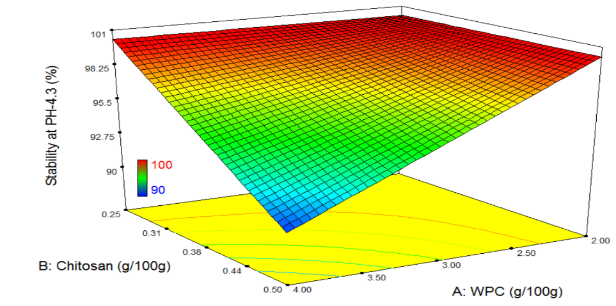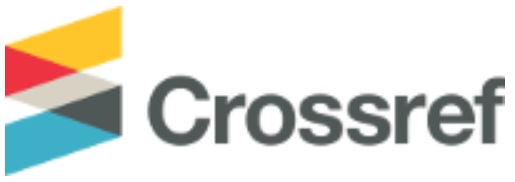Encapsulation of Vitamins E and C in Whey Protein Concentrate-Chitosan Emulation: Physicochemical Properties
Keywords:
Encapsulation, Emulsion, whey protein concentration, chitosanAbstract
This study investigated the use of different ratios of whey protein concentrate (WPC) and chitosan (Cs) in encapsulating vitamins C and E. The aim of this research is the stability of vitamins C and E in environmental conditions. In this study, experimentally, the effect of different amounts of WPC and Cs on the chemical and physical properties of samples containing vitamin C and E is evaluated. The chemical and physical structures of the emulsions including (apparent viscosity, zeta potential, particle size, emulsion stability at pH 4.3 and 6.3 and the encapsulation efficiency of vitamins C and E) were investigated. The data was analyzed using Design Expert software. The main finding this study, the particle size, zeta potential, viscosity, emulsion stability in pH 4.3 and 6.3, and encapsulation efficiency of vitamins E and C varied from 255 to 595 nm, +20.11 to 31.77 mV, and 28.45 to 45.67 cP, 90 to 100% and 60 to 90%, and 93.83 to 93.36% and 93.60 to 77.33% respectively(p<0.05). In general, based on the results obtained from the response level, treatment 9 (WPC: Cs, 2: 0.25) at pH 4.3 had the lowest viscosity, particle size, and the highest particle size and encapsulation efficiency.
References
Alishahi, A. (2014). Antibacterial effect of chitosan nanoparticle loaded with nisin for the prolonged effect. Journal of Food Safety, 34(2), 111-118.
AOAC. (2005). Determination of Moisture, Ash, Protein and Fat. In Official Method of Analysis of the Association of Analytical Chemists (pp. 141–144). AOAC Washington, DC, USA.
Assadpour, E., & Jafari, S. M. (2017). Spray drying of folic acid within nano-emulsions: optimization by Taguchi approach. Drying Technology, 35(9), 1152-1160.
Barbosa, C., Santos-Pereira, C., Soares, I., Martins, V., Terra-Matos, J., Côrte-Real, M., ... & Gerós, H. (2019). Resveratrol-loaded lipid nanocarriers are internalized by endocytosis in yeast. Journal of natural products, 82(5), 1240-1249.
Budinčić, J. M., Petrović, L., Đekić, L., Fraj, J., Bučko, S., Katona, J., & Spasojević, L. (2021). Study of vitamin E microencapsulation and controlled release from chitosan/sodium lauryl ether sulfate microcapsules. Carbohydrate Polymers, 251, 116988.
Chang, C., Wang, T., Hu, Q., & Luo, Y. (2017). Caseinate-zein-polysaccharide complex nanoparticles as potential oral delivery vehicles for curcumin: Effect of polysaccharide type and chemical cross-linking. Food Hydrocolloids, 72, 254–262.
Chen, C., Zhang, B., Fu, X., You, L. J., Abbasi, A. M., & Liu, R. H. (2016). The digestibility of mulberry fruit polysaccharides and its impact on lipolysis under simulated saliva, gastric and intestinal conditions. Food Hydrocolloids, 58, 171–178.
Chen, H., Mao, L., Hou, Z., Yuan, F., & Gao, Y. (2020). Roles of additional emulsifiers in the structures of emulsion gels and stability of vitamin E. Food Hydrocolloids, 99.
Chen, X., McClements, D. J., Wang, J., Zou, L., Deng, S., Liu, W., Yan, C., Zhu, Y., Cheng, C., & Liu, C. (2018). Coencapsulation of (-)-Epigallocatechin-3-gallate and Quercetin in Particle-Stabilized W/O/W Emulsion Gels: Controlled Release and Bioaccessibility. Journal of Agricultural and Food Chemistry, 66(14), 3691–3699.
Desai, K. G., Liu, C., & Park, H. J. (2006). Characteristics of vitamin C encapsulated tripolyphosphate-chitosan microspheres as affected by chitosan molecular weight. Journal of microencapsulation, 23(1), 79-90.
De Queiroz, J. L. C., Costa, R. O. D. A., Matias, L. L. R., De Medeiros, A. F., Gomes, A. F. T., Pais, T. D. S., ... & Morais, A. H. D. A. (2018). Chitosan-whey protein nanoparticles improve encapsulation efficiency and stability of a trypsin inhibitor isolated from Tamarindus indica L. Food Hydrocolloids, 84, 247-256.
El-Sayed, M. M., Hassan, Z. M. R., Awad, M. I. F. R. A., & Salama, H. (2015). Chitosan-whey protein complex (cs-wp) as delivery systems to improve bioavailability of iron. Int. J. Appl. Pure Sci. Agric, 1, 34-46.
Ge, J., Yue, P., Chi, J., Liang, J., & Gao, X. (2018). Formation and stability of anthocyanins-loaded nanocomplexes prepared with chitosan hydrochloride and carboxymethyl chitosan. Food Hydrocolloids, 74, 23–31.
Ghasemi, S., Jafari, S. M., Assadpour, E., & Khomeiri, M. (2018). Nanoencapsulation of d-limonene within nanocarriers produced by pectin-whey protein complexes. Food Hydrocolloids, 77, 152-162.
Ghasemi, S., Jafari, S. M., Assadpour, E., & Khomeiri, M. (2018). Nanoencapsulation of d-limonene within nanocarriers produced by pectin-whey protein complexes. Food Hydrocolloids, 77, 152–162.
Ghobadi, M., Koocheki, A., Varidi, M. J., & Varidi, M. (2021). Encapsulation of curcumin using Grass pea (Lathyrus sativus) protein isolate/Alyssum homolocarpum seed gum complex nanoparticles. Innovative Food Science & Emerging Technologies, 72, 102728.
Hassane Hamadou, A., Zhang, J., Chen, C., Xu, J., & Xu, B. (2023). Vitamin C and β-carotene co-loaded in marine and egg nanoliposomes. Journal of Food Engineering, 340, 111315.
Hinnenkamp, C., & Ismail, B. P. (2021). Enhancing emulsion stability: The synergistic effect of combining Procream and partially hydrolyzed whey protein. International Dairy Journal, 119, 105059.
Huang, E., Quek, S. Y., Fu, N., Wu, W. D., & Chen, X. D. (2019). Co-encapsulation of coenzyme Q10 and vitamin E: A study of microcapsule formation and its relation to structure and functionalities using single droplet drying and micro-fluidic-jet spray drying. Journal of Food Engineering, 247, 45–55.
Jamshidi, A., Shabanpour, B., Pourashouri, P., & Raeisi, M. (2018). Using WPC-inulin-fucoidan complexes for encapsulation of fish protein hydrolysate and fish oil in W1/O/W2 emulsion: Characterization and nutritional quality. Food Research International, 114, 240–250.
Katouzian, I., & Jafari, S. M. (2016). Nano-encapsulation as a promising approach for targeted delivery and controlled release of vitamins. In Trends in Food Science and Technology. https://doi.org/10.1016/j.tifs.2016.05.002
Khan, M. A., Yue, C., Fang, Z., Hu, S., Cheng, H., Bakry, A. M., & Liang, L. (2019). Alginate/chitosan-coated zein nanoparticles for the delivery of resveratrol. Journal of Food Engineering, 258, 45–53.
Kheynoor, N., Hosseini, S. M. H., Yousefi, G. H., Hashemi Gahruie, H., & Mesbahi, G. R. (2018). Encapsulation of vitamin C in a rebaudioside-sweetened model beverage using water in oil in water double emulsions. LWT, 96, 419–425.
Laila, U., & Pudjiraharti, S. (2019). Microencapsulation of Purple-Fleshed Sweet Potato Anthocyanins with Chitosan-Sodium Tripolyphosphate by Using Emulsification-Crosslinking Technique. Journal of Mathematical & Fundamental Sciences, 50(1).
Liu, Q., Qin, Y., Jiang, B., Chen, J., & Zhang, T. (2022). Development of self-assembled zein-fucoidan complex nanoparticles as a delivery system for resveratrol. Colloids and Surfaces B: Biointerfaces, 216, 112529.
Liu, X., Wang, P., Zou, Y. X., Luo, Z. G., & Tamer, T. M. (2020). Co-encapsulation of Vitamin C and β-Carotene in liposomes: Storage stability, antioxidant activity, and in vitro gastrointestinal digestion. Food Research International, 136, 109587.
Luo, Y., Zhang, B., Whent, M., Yu, L. L., & Wang, Q. (2011). Preparation and characterization of zein/chitosan complex for encapsulation of α-tocopherol, and its in vitro controlled release study. Colloids and Surfaces B: Biointerfaces, 85(2), 145–152.
Mohammadi, A., Jafari, S. M., Esfanjani, A. F., & Akhavan, S. (2016). Application of nano-encapsulated olive leaf extract in controlling the oxidative stability of soybean oil. Food Chemistry, 190, 513–519.
Niu, F., Gu, F., Zhao, M., Gao, Y., Tu, W., Kou, M., & Pan, W. (2023). Aggregation and Growth Mechanism of Ovalbumin and Sodium Carboxymethylcellulose Colloidal Particles under Thermal Induction. Biomacromolecules, 24(3), 1532–1543.
Öztürk, B. (2017). Nanoemulsions for food fortification with lipophilic vitamins: Production challenges, stability, and bioavailability. In European Journal of Lipid Science and Technology.
Rajabi, H., Jafari, S. M., Rajabzadeh, G., Sarfarazi, M., & Sedaghati, S. (2019). Chitosan-gum Arabic complex nanocarriers for encapsulation of saffron bioactive components. Colloids and Surfaces A: Physicochemical and Engineering Aspects, 578, 123644.
Ramakrishnan, Y., Adzahan, N. M., Yusof, Y. A., & Muhammad, K. (2018). Effect of wall materials on the spray drying efficiency, powder properties and stability of bioactive compounds in tamarillo juice microencapsulation. Powder technology, 328, 406-414.
Rashid, R., Wani, S. M., Manzoor, S., Masoodi, F. A., & Dar, M. M. (2022). Improving oxidative stability of edible oils with nanoencapsulated orange peel extract powder during accelerated shelf life storage. Food Bioscience, 49, 101917.
Rutz, J. K., Borges, C. D., Zambiazi, R. C., Crizel-Cardozo, M. M., Kuck, L. S., & Noreña, C. P. Z. (2017). Microencapsulation of palm oil by complex coacervation for application in food systems. Food Chemistry, 220, 59–66.
Santana, A. A., Cano-Higuita, D. M., De Oliveira, R. A., & Telis, V. R. N. (2016). Influence of different combinations of wall materials on the microencapsulation of jussara pulp (Euterpe edulis) by spray drying. Food Chemistry, 212, 1–9.
Shin, H. J., Chang, J. H., & Han, J. A. (2023). Physicochemical and in-vitro release characteristics of vitamin C-loaded antioxidant orally disintegrating films with different catechin levels. Food Bioscience, 53, 102733.
Soleimanifard, M., Feizy, J., & Maestrelli, F. (2021). Nanoencapsulation of propolis extract by sodium caseinate-maltodextrin complexes. Food and Bioproducts Processing, 128, 177–185. https://doi.org/10.1016/J.FBP.2021.05.005
Wang, L., Gao, Y., Li, J., Subirade, M., Song, Y., & Liang, L. (2016). Effect of resveratrol or ascorbic acid on the stability of α-tocopherol in O/W emulsions stabilized by whey protein isolate: Simultaneous encapsulation of the vitamin and the protective antioxidant. Food Chemistry, 196, 466-474.
Wang, X., Ding, Z., Zhao, Y., Prakash, S., Liu, W., Han, J., & Wang, Z. (2021). Effects of lutein particle size in embedding emulsions on encapsulation efficiency, storage stability, and dissolution rate of microencapsules through spray drying. Lwt, 146, 111430.
Wusigale, Liang, L., & Luo, Y. (2020). Casein and pectin: Structures, interactions, and applications. Trends in Food Science and Technology, 97, 391–403.
Yadollahi, Z., Motiei, M., Kazantseva, N., Císař, J., & Sáha, P. (2023). Whey Protein Isolate-Chitosan PolyElectrolyte Nanoparticles as a Drug Delivery System. Molecules 2023, Vol. 28, Page 1724, 28(4), 1724.
Ye, A. (2008). Complexation between milk proteins and polysaccharides via electrostatic interaction: principles and applications–a review. International journal of food science & technology, 43(3), 406-415.
Yousefi, S., Rajaei, P., Nateghi, L., Nodeh, H. R., & Rashidi, L. (2023). Encapsulation of sesamol and retinol using alginate and chitosan-coated W/O/W multiple emulsions containing Tween 80 and Span 80. International Journal of Biological Macromolecules, 242, 124766.
Zahran, H., Bat, H., & Şahin-Yeşilçubuk, N. (2022). Influence of wall material combination on the lipid oxidation of the hazelnut oil microcapsules. Discover Food, 2(1), 17.
Ziani, K., Fang, Y., & McClements, D. J. (2012). Fabrication and stability of colloidal delivery systems for flavor oils: Effect of composition and storage conditions. Food Research International, 46(1), 209-216.












